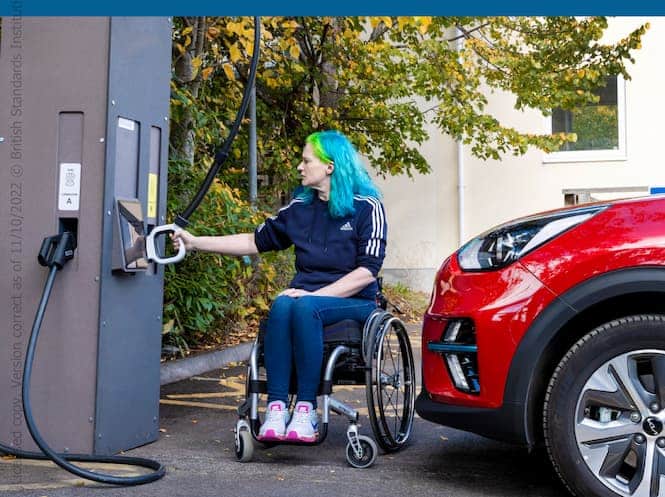
EV Accessibility — BSI Standards Group
Here is a pdf of accessibility standards PAS 1899:2022
84 pages.
Enabling more accessible EV charge points
What’s happened and why?
Intending to provide an inclusive experience for people with accessibility needs, PAS 1899:2022 is a new standard giving designers, procurers and installers essential specifications on providing accessible public charge points for electric vehicles.
What does PAS 1899:2022 cover?
It covers the physical aspects of the environment surrounding fixed charge points (e.g. kerb height, ground type); the location, placement and spacing of charge points within the streetscape/public realm; the information, signals and indicators to be provided to users; and the factors to be taken into account in the design and specification of accessible charge points (e.g. height of charge point, cables and cable management systems, bollard spacing, colours used on screens, weight and force and ease of use of the equipment).
Why use PAS 1899:2022?
It aims to support building an inclusive EV charging infrastructure in the UK. As such it can help designers, procurers and installers to:
- Anticipate and overcome restrictions and barriers that could prevent any user from making full and independent use of the charge point
- Accelerate innovative practices
- Improve the efficiency with which EV charge points are deployed
- Build confidence in the accessibility and inclusivity of EV infrastructure
- Strengthen the risk management of EV projects
Owners and operators can also use the PAS to assess the accessibility of their existing charge points.
Gee, what about Europe?
Many of the accessibility (and usability) issues such as the positioning of the charging points, the access around them, the heights of the various elements that the user interacts with will all fall under the scope of EN 17210:2021 on “Accessibility and usability of the built environment – Functional requirements” and the accompanying report that gives some of the actual dimensions that the EN lacks. EN 17210 defines the “built environment” quite broadly:
“external and internal environments and any element, component or fitting that is commissioned, designed, constructed and managed for use by people”. This standard has been published by CEN/CENELEC JTC 11.
EN 301 549 on “Accessibility requirements for ICT products and services” has clause 8.3 that applies to the physical design of “Stationary ICT” which is defined as “ICT that stands on the floor, or is mounted on a wall or other immovable structure, and is not intended to be moved by its user”. So, if an EV charging station was designed as a pedestal that is mounted on the ground or a box that is mounted on the wall, then the position of controls and screens on the pedestal or the box would be covered by clause 8.3, but where that box was mounted on the wall or whether the pedestal is stood on something would be covered by EN 17210. EN 301 549 has been developed by ETSI and published jointly by CEN CENELEC and ETSI.
Accessibility requirements relating to how the control software for the EV charging station interacts with the user (e.g. via (touch-)screens, buttons and audio) is covered by various clauses in EN 301 549.
Looking to the future, the European Commission has recently issued a mandate to the three European Standardisation Organisations (CEN CENELEC and ETSI) to revise the two harmonized European Standards above and new versions of them are in preparation for publication at the end of the summer 2025.
